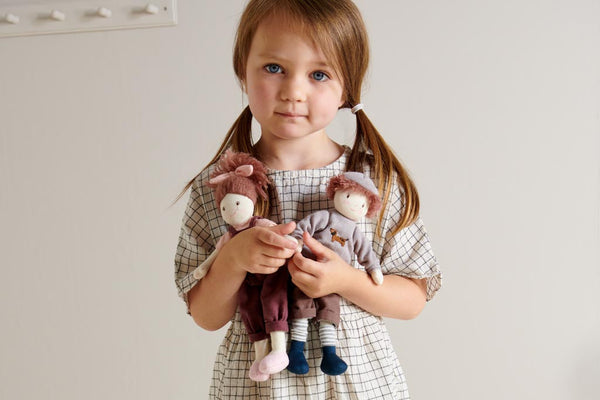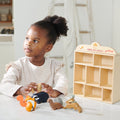Gift Guide | Toys for Preschoolers

The years before your child starts school are a time of wonder. It’s the time of Father Christmas, the Tooth Fairy - and magic. Above all, it’s a time before reality intrudes, of make-believe and let’s pretend.
The toddler years are behind us. There’s still room for exploration but all the intense experimentation and discovery of heuristic play now makes way for the imagination.
What does that mean for toys?
The best toys for preschoolers
- Wooden railway
- Doll’s house
- Puppet theatre
- Wooden play shop
- Toy kitchen
- Vehicles
- Loose parts
- Peg people
- Wooden animals
- Small world toys
- Tinker trays
Wooden railway
A wooden railway has a hypnotic effect. Watch the trains go round again and again.
Nothing changes. The route is always the same.
So what’s the appeal?
Like scientists, children like to test one variable at a time. Preschoolers are driven to learn key concepts like through, around, between, back and forth, in and out. The track limits the train’s movement, making the possible outcomes more knowable and new learning easier to grasp.
So children push their train into a tunnel and back again, a hundred times. It never gets stale. They look at it disappearing and re-emerging. They lie down on the floor to see the action unfold from a different angle. They raise the tunnel at one end to create a slope to see how this affects the movement. They are always testing.
This is schema play.
Once it is mastered, the train set takes on a new life. It becomes a hub for imaginative play, for stories and adventure. Add wooden figures and give them a role to play. Retrieve the forgotten arches, tunnels and stackers from the toddler toy box - they are now the tunnels and bridges of your new city.
Doll’s houses
The doll’s house is perhaps the quintessential preschool toy. It encourages language, emotional intelligence and story-telling as well as reinforcing the spatial reasoning developed during the toddler years.
Children recreate scenes from everyday life and try to make sense of their world. What does it mean to be a brother and a son? What happens when a child misbehaves?
Perhaps your child creates an alter ego through which to live out her more transgressive fantasies. What would happen if I pushed the bed down the stairs? How would Daddy react if I stood on the kitchen table?
A doll’s house gives years of play, either alone or alongside others.
Puppet theatre
Build up a collection of puppets or make your own - it doesn’t matter. The most important thing is to tell a story, to get talking.
Puppet theatres encourage language development and the imagination. They draw children’s attention to the difference between narration and direct speech.
When children reach school, they will draw on this rich history of play to inform their writing.
Play kitchens
Your child wants to be you.
My son wants to make coffee the way I do every morning. My daughter wants to put the croissants in the oven.
They are both too young to do this alone but the urge to imitate close adults is strong.
What’s the answer?
A play kitchen.
Simple domestic routines hold no interest to us as adults but for our children they are fascinating.
And when they finally tire of making their umpteenth cappuccino, the kitchen can be transformed into an office, a space ship or the school canteen.
See play kitchens.

Vehicles
Vehicle play is easy to dismiss. Boys going vroom, vroom! The dialogue is often non-existent and the actions repetitive.
So why does it have such hold on so many children?
You guessed it. Schemas, again.
Like the wooden railway, vehicle play allows children to explore movement-related ideas like over, under and through. These are vital concepts that build towards later mathematical understanding. But our children don’t know that yet. They just know that this kind of play is fun.
Loose parts
Loose parts play is the oldest kind of play there is.
It is something our ancestors would have enjoyed. Small, movable objects like stones and acorns, gathered, sorted and arranged. It sounds simple but the underlying concepts are foundational.
Use them to count, sort, make patterns or transient art. There’s no end to the possibilities.
Peg people
Babies and toddlers enjoy using peg people to place, position and post but the appeal of these toys doesn’t end when children reach the preschool years. These simple figures are easy to incorporate into small world play. It's one of the reasons they are such a well-loved, toy-box staple.
Wooden animals
Like peg people, wooden animals are a toy-box essential. Choose figures that go together rather than a random assortment and you have a readymade world. Think of the stories Beatrix Potter told with just a fox, a badger and some rabbits.

Small world play
Small world play is the recreation of the world in miniature. Make a scene and populate it with figures, whether animal or human. Add vehicles and structures, rivers and roads. Or draw it out with chalk on the ground or lines of tape on the floor.
The essential goal is to give your dolls a place - and a reason - to interact.
Whether you choose a doll’s house or a space station, a train set or a castle will depend on your child’s interests, but the learning is still the same.
Sorting and classifying
Where does this acorn go? With the pine cones or the nuts? Or does it need a compartment of its own?
A tinker tray is the perfect introduction to sorting and classifying - essential skills for school-age children.
The mere presence of all these divisions in the box invites us to make a choice about what to put where.
How will we discriminate? By size, colour, texture or material? Or perhaps something else altogether?
There’s a lot of good thinking going on here.

Rag dolls & soft toys
We often buy rag dolls and soft toys for our newborns but apart from adorning the nursery for that first year, they offer very little in terms of play value.
After a while, the number of toys accumulates and it’s tempting to send them to the charity shop. They aren’t getting much use.
But wait!
We are now entering the golden age of the soft toy.
One day, during the preschool years, your child will rediscover them.
They become reliable companions, following along whenever new or challenging situations arise. They are the first name on the list at the teddy bears’ picnic. And if you have a trolley or a sling, they become a baby to be loved and transported.
Final word
The preschool years are the high point of play. The exploration and discover of toddlerdom has made way for more sophisticated games of the imagination. Reality has not yet encroached and there is an innocence to children’s play that will soon be lost.
It’s a time to savour and enjoy.









